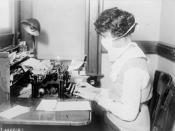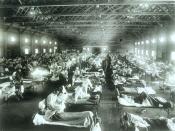Considering the esteem our country is currently being held in, it is a time to check our national defense. One has to make sure that our arsenals are full of bombs and that our shelters are stocked with food. One major threat to the United States right now is bio-terrorism. By looking at past epidemic situations, we can see to what capacity this country has been able to help the ailing masses and prevent the infection of others. Because of the many people across America were affected by the 1918 influenza epidemic, it is a comparable event when thinking about the responses to a bio-terrorism incident.
The 1918 influenza epidemic is one of the most devastating epidemics in United States' history is the 1918 influenza epidemic. Twenty-five percent of Americans were infected and 500,000 people died (Schoch-Spana 2001, S32). This outbreak earned the name "Spanish influenza" not because of its origins, but because the epidemic received a lot of publicity in Spain, a country with uncensored press that was uninvolved in World War I (Schoch-Spana 2000, 1410).
It is uncertain where the initial outbreak occurred; however, most sources say that it began in the United States in the spring of 1918. The disease was most prevalent toward the end of World War I. It was initially spread through the United States troops who were brought to the Allied front. By the end of 1918, Spanish influenza had spread to six continents from heavily populated cultural centers to remote islands (Vaughan 1920). The impact of the 1918 Influenza Epidemic further discredited some prevention and treatment methods while leaving us with waiting it out as our only choice for remedies for future epidemics.
Unknown to many of its citizens, the Spanish influenza was making its return trip to America in August of...


